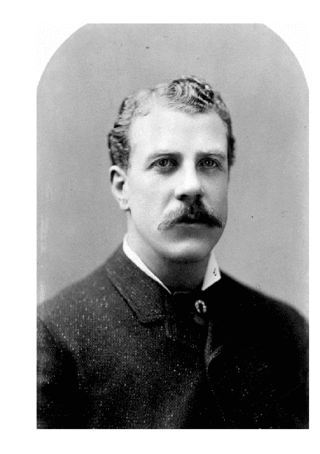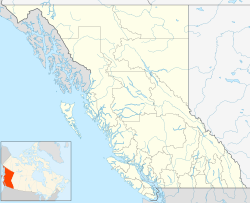100 Mile House is a district municipality located in the South Cariboo region of central British Columbia, Canada.

Charles Augustus "Charlie" Semlin was a Canadian politician and rancher.
Highway 97 is a major highway in the Canadian province of British Columbia. It is the longest continuously numbered route in the province, running 2,081 km (1,293 mi) and is the only route that runs the entire north–south length of the British Columbia, connecting the Canada–United States border near Osoyoos in the south to the British Columbia–Yukon boundary in the north at Watson Lake, Yukon.

Hewitt Bostock, was a Canadian publisher, businessman and politician.
Cariboo was one of the twelve original electoral districts created when British Columbia became a Canadian province in 1871. Roughly corresponding to the old colonial electoral administrative district of the same name, it was a three-member riding until the 1894 election, when it was reduced through reapportionment and became a two-member riding until the 1916 election, after which it has been a single-member riding. It produced many notable Members of the Legislative Assembly (MLAs), including George Anthony Boomer Walkem, third and fifth holder of the office of Premier of British Columbia and who was one of the first representatives elected from the riding; John Robson, ninth Premier of British Columbia; and Robert Bonner, a powerful minister in the W.A.C. Bennett cabinet, and later CEO of MacMillan Bloedel and BC Hydro.
In 1865, James Todd (1832–1925) and his family established a ranch south-east of Kamloops, British Columbia. He and Lew Campbell could be considered the first settlers of Barnhartvale, British Columbia.

Heffley Creek is a neighbourhood of Kamloops, British Columbia, Canada along Highway 5. The city's northernmost community, it is bordered by the North Thompson River to the west, Sun Peaks to the east, Rayleigh to the south, and Vinsulla to the north. It contains a general store, community hall and elementary school. Along with the Rayleigh neighborhood, it is physically separated from the rest of Kamloops by the Thompson River and by the Kamloops Indian Reserve; Heffley Creek is located within the limits of the City of Kamloops.

Clinton is a village in British Columbia, Canada, located approximately 40 km (25 mi) northwest of Cache Creek and 30 km south of 70 Mile House.

Barnard's Express, later known as the British Columbia Express Company or BX, was a pioneer transportation company that served the Cariboo and Fraser-Fort George regions in British Columbia, Canada from 1861 until 1921.

The Churn Creek Protected Area is a 36,747-hectare (90,800-acre) provincial protected area in British Columbia, Canada. It is a mix of dryland canyon and steppe and adjoining rangeland flanking the canyon of Churn Creek and that stream's confluence with the Fraser River at the northern apex of the Camelsfoot Range. The historic Gang Ranch is just north of the Churn Creek Protected Area. The Empire Valley Ranch ecological preserve was added to the Protected Area in an expansion.
Franz Xavier Richter, commonly known as Frank Richter, was a pioneer settler, miner and rancher in 19th century Washington and British Columbia.

Gustavus Blin Wright was a pioneer roadbuilder and entrepreneur in British Columbia, Canada. His biggest achievement was building the Old Cariboo Road to the Cariboo gold fields, from Lillooet to Fort Alexandria, but he was also a partner in a freighting firm that operated on the Douglas Road, he ran a toll bridge at Bridge River, near Lillooet, and built part of the road from Quesnel to Barkerville. He was also the original owner of the town of 70 Mile House.

Stephen Tingley was a stagecoach driver and one of the original owners of the pioneer transportation company BC Express that served the Cariboo region in British Columbia, Canada for 60 years, from 1860, when it was first founded as Barnard's Express, until 1920, when it ceased its sternwheeler service.

John Irving was a steamship captain in British Columbia, Canada. He began on the Fraser River at the age of 18 and would become one of the most famous and prosperous riverboat captains of the era. His father, William Irving, was known as the "King of the River" and the neighborhood of Irvington in Portland, Oregon is named in honor of their family.

Thompson Country, also referred to as The Thompson and sometimes as the Thompson Valley and historically known as the Couteau Country or Couteau District, is a historic geographic region of the Southern Interior of British Columbia, more or less defined by the basin of the Thompson River. This is a tributary of the Fraser; the major city in the area is Kamloops.
Australian is an unincorporated community on the east side of the Fraser River in the North Cariboo region of central British Columbia. On BC Highway 97, the locality is by road about 85 kilometres (53 mi) north of Williams Lake and 33 kilometres (21 mi) south of Quesnel.
Pavilion Mountain is the highest summit of the southern Marble Range in the South Cariboo region of southwestern British Columbia. "Mount Carson", a subsidiary peak, was misapplied to the whole mountain 1957–1965, before the well-established local name was restored. Pavilion Creek is to the south. Pavilion Lake and Marble Canyon are to the southeast.
Dog Creek is an unincorporated ranching settlement, located on the Fraser River, in the Cariboo region of British Columbia, Canada. Located on the northeast side of the Fraser's confluence with Dog Creek, it is opposite Gang Ranch on the west side of the river, which is connected by an old suspension bridge serving local ranch roads. Dog Creek's first post office opened in 1873. The Dog Creek reserves of the Canoe Creek/Dog Creek Indian Band are located east of the settlement. The ranches at Dog Creek, along with the Gang Ranch, mostly hire First Nations cowboys, most of them coming from the Canoe Creek/Dog Creek Band.
William Adams was a farmer and political figure in British Columbia. He represented Cariboo in the Legislative Assembly of British Columbia from 1893 to 1898.
The O'Keefe Ranch is a historic ranch in the Okanagan region of British Columbia, Canada on the Canadian National Railway, just northwest of Vernon. The ranch was founded in 1867 by Cornelius O'Keefe.










